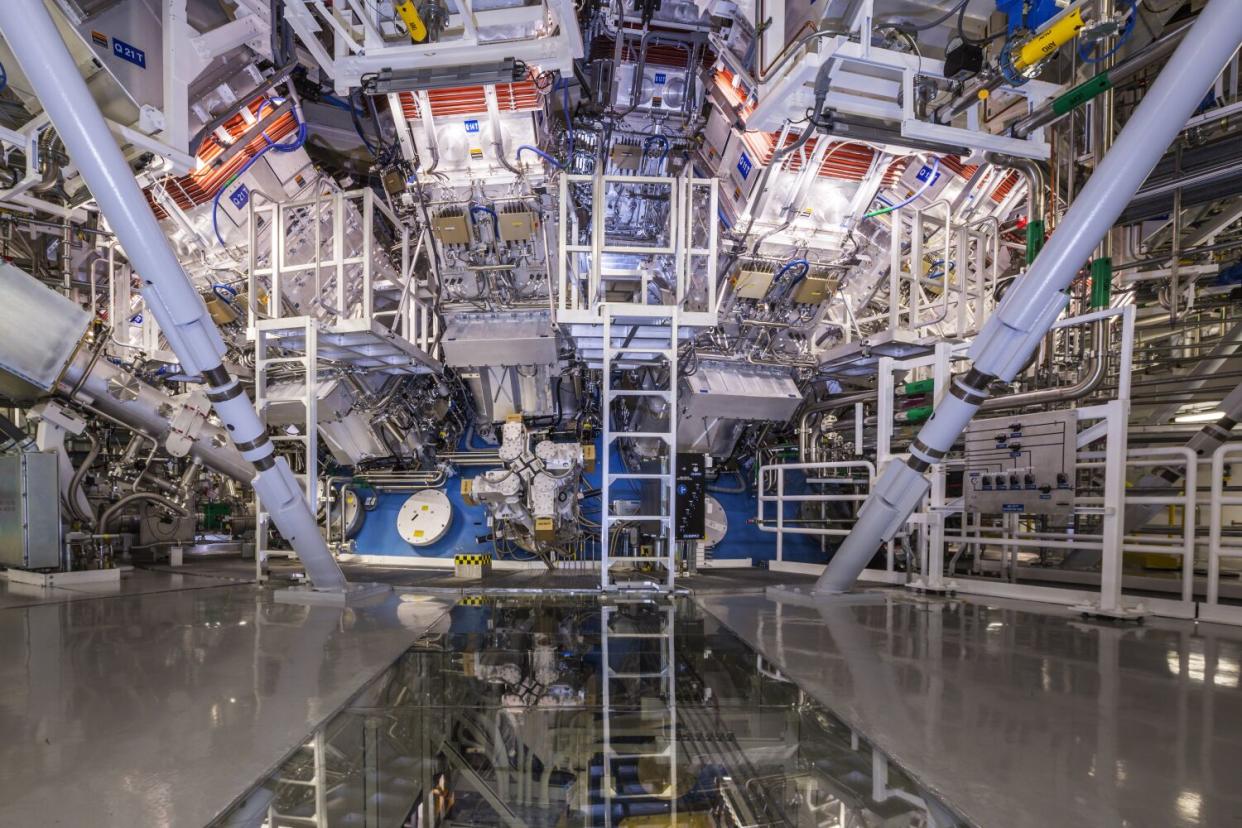Nuclear fusion breakthrough in California seen as milestone toward clean energy future
In a first, U.S. scientists have created “net energy” through a nuclear fusion reaction, the Department of Energy announced Tuesday.
The successful experiment, which took place Dec. 5 at Lawrence Livermore National Laboratory, is the most significant milestone yet reached in the decades-long quest to produce cheap, clean, carbon-free energy through nuclear fusion.
“We have taken the first tentative steps toward a clean energy source that could revolutionize the world,” said Jill Hruby, administrator of the National Nuclear Security Administration.
Energy Secretary Jennifer M. Granholm called the achievement “one of the most impressive scientific feats of the 21st century,” adding that it “will go down in the history books.”
In a nuclear fusion reaction, two atoms slam together and merge into a larger atom of a heavier element, releasing their excess mass in the form of energy.
Fusion is the process through which the sun makes energy. The sun’s core is the ideal high-pressure, high-temperature environment for hydrogen atoms to fuse into helium; replicating those conditions on Earth has proved difficult.
Scientists at Lawrence Livermore in the San Francisco Bay Area achieved their breakthrough by training 192 lasers at a diamond-coated target roughly the size of a peppercorn, heating it to more than 3 million degrees Celsius (more than 5.4 million degrees Fahrenheit) and — briefly — mimicking the conditions of a star. Fusion began.
“This had all happened before. One hundred times before,” said Marvin Adams, the National Nuclear Security Administration’s deputy administrator for defense programs. “But last week, for the first time, they designed this experiment so that the fusion fuel stayed hot enough, dense enough and round enough for long enough that it ignited and produced more energy than the lasers had deposited.”
That net energy gain was “about two megajoules in, about three megajoules out,” Adams said.

A fusion reaction generates three to four times as much energy as fission, which itself is roughly a million times more powerful than any other energy source on Earth.
Nuclear fission, or the splitting of atoms, releases a massive amount of energy in a chain reaction. Fission reactions have been channeled productively into nuclear power plants and destructively into nuclear weapons.
Unlike fission, nuclear fusion does not release harmful radioactive byproducts that take thousands of years to decay. And since it doesn’t involve a chain reaction, it’s intrinsically less dangerous.
In addition, fusion has long been seen as key to the goal of achieving net-zero emissions. Electricity and heat production currently account for 30% of global greenhouse gas emissions. A technology that successfully harnesses nuclear fusion could, in theory, create endlessly renewable amounts of clean, low-risk, carbon-free energy.
All of these factors have made controllable nuclear fusion one of science’s most sought-after goals since the 1950s, attracting billions in government and private investment.
“We’ve taken a technology that was born for destruction, and we’ve now opened the door to it being used for more than that,” said Lee Bernstein, a professor of nuclear engineering at UC Berkeley and former deputy group leader at the Livermore Laboratory’s National Ignition Facility, where the experiment took place.
While Tuesday’s announcement is a major step toward that ideal, there’s a long road ahead. Any practical application is likely “decades” away, said Kim Budil, Livermore’s director.
“This is one igniting capsule, one time. To realize commercial fusion energy, you have to do many things. You have to be able to produce many, many fusion ignition events per minute,” Budil said. “With concerted effort and investment, a few decades of research on the underlying technologies could put us in a position to build a power plant.”
Indeed, the achievement at Livermore is “a little bit like the Wright brothers’ first flight,” said Paul Bellan, a plasma physicist at Caltech.
With their self-designed airplane, Orville and Wilbur Wright proved in 1903 that “you could make a heavier-than-air craft that would take off and fly and not fall down,” Bellan said. But, he noted, “it didn’t mean you could fly from Los Angeles to London” right away.
Nor did it mean the Wrights’ plane was the only feasible design for an aircraft, he added. But it proved that a bold leap in physics was possible, and inspired others to build upon their success.
“It’s a defining moment, certainly,” Bellan said. “It shows that it’s worth working on, and eventually, we’ll get to something that will be profitable.”
While it might take decades for fusion to reach commercial readiness, nuclear fission has helped power the U.S. for decades.
Ninety-three nuclear reactors generated nearly one-fifth of the nation’s electricity last year; among them is the Palo Verde plant off Interstate 10 in Arizona, which supplies Los Angeles and other cities as the country’s largest electricity generator. President Biden sees nuclear power as crucial to meeting his goal of 100% climate-friendly electricity by 2035.
Even before Tuesday’s announcement, a string of successes at the National Ignition Facility had inspired new generations of scientific talent.
Since August 2021, when the team reached a key threshold in achieving a self-perpetuating reaction, student interest in fusion has surged, said Siegfried Glenzer, a photon science professor at Stanford University and a division director at SLAC National Accelerator Laboratory.
“This is really a big magnet now for young people who want to make a difference in the world. Many are driven by climate change, and they want to see a
carbon-free energy source being produced,” Glenzer said. “It’s an exciting time for researchers of any age.”
Times staff writer Sammy Roth contributed to this report.
This story originally appeared in Los Angeles Times.
